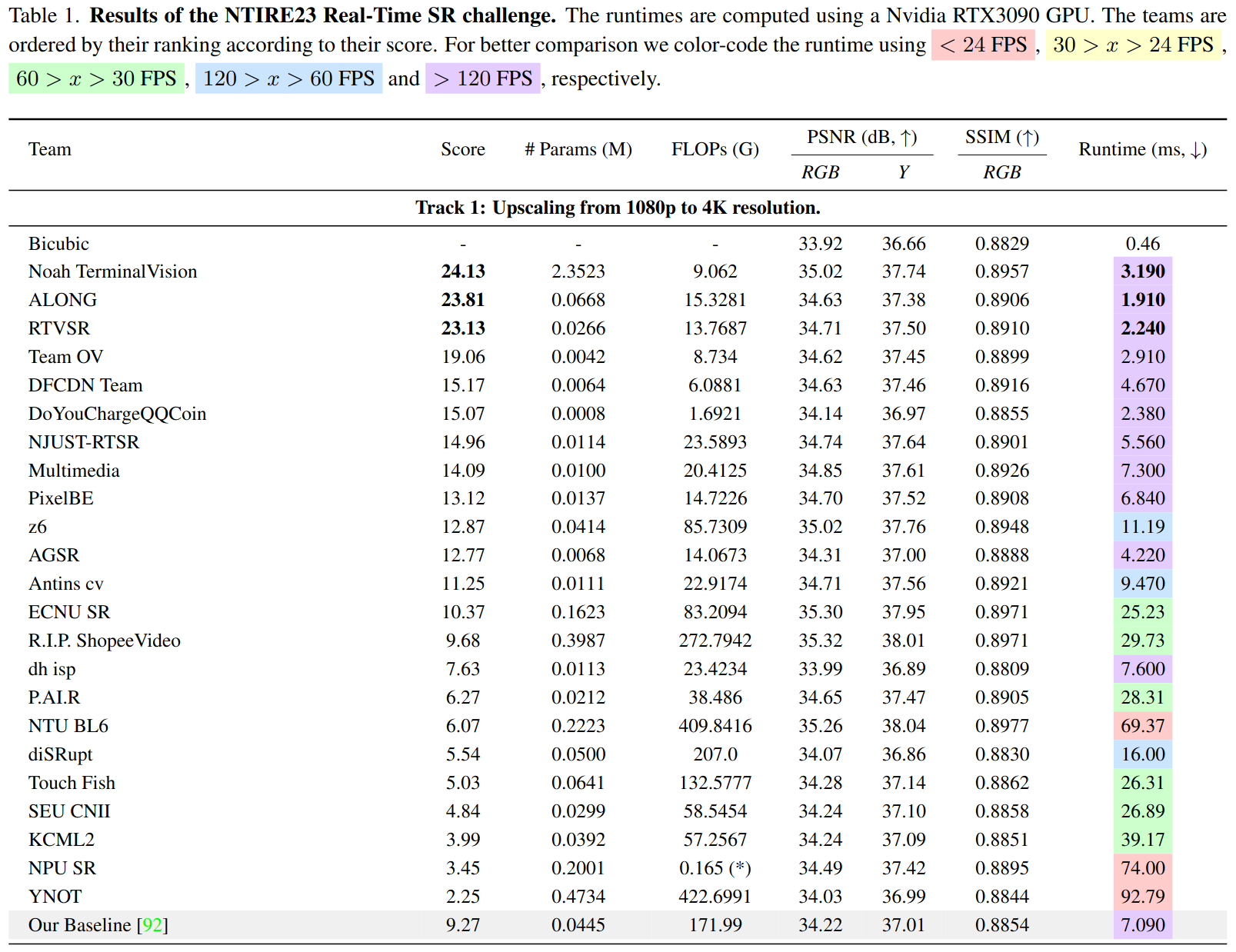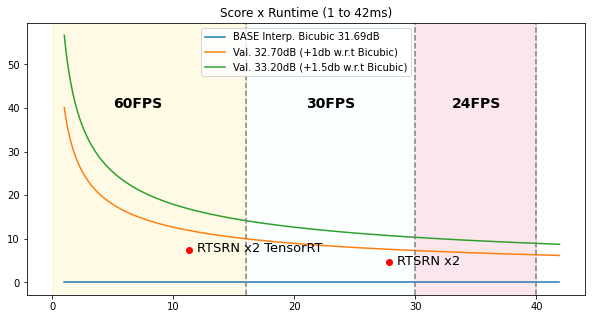NTIRE Real-Time 4K Super-Resolution @ CVPR 2023
Marcos V. Conde, Eduard Zamfir, Radu Timofte
Computer Vision Lab, CAIDAS, University of Würzburg
 |
 |
🚀 🚀 🚀 News
- "Efficient Deep Models for Real-Time 4K Image Super-Resolution. NTIRE 2023 Benchmark and Report"
- "Towards Real-Time 4K Image Super-Resolution"
- Project website
- Dataset release soon (mid-June)
- Presentation June 18th NTIRE workshop.
Citation
@InProceedings{Conde_2023_CVPR,
author = {Conde, Marcos V. and Zamfir, Eduard and Timofte, Radu and Motilla, Daniel and others},
title = {Efficient Deep Models for Real-Time 4K Image Super-Resolution. NTIRE 2023 Benchmark and Report},
booktitle = {Proceedings of the IEEE/CVF Conference on Computer Vision and Pattern Recognition (CVPR) Workshops},
month = {June},
year = {2023},
pages = {1495-1521}
}
@InProceedings{Zamfir_2023_CVPR,
author = {Zamfir, Eduard and Conde, Marcos V. and Timofte, Radu},
title = {Towards Real-Time 4K Image Super-Resolution},
booktitle = {Proceedings of the IEEE/CVF Conference on Computer Vision and Pattern Recognition (CVPR) Workshops},
month = {June},
year = {2023},
pages = {1522-1532}
}
The 8th edition of NTIRE: New Trends in Image Restoration and Enhancement workshop will be held on June 18th, 2023 in conjunction with CVPR 2023. Top solutions will be presented at the NTIRE Workshop, and will appear in the conference proceedings.
Image Super-Resolution is one of the most popular computer vision problems due to its real-world applications: photography, gaming, generative AI, etc. The goal of the NTIRE 2023 Real-Time Super-Resolution Challenge is to upscale images in real-time at 30-60FPS using deep learning models and commercial GPUs (RTX 3060, 3090). The input images can be large patches or full-resolution images, compressed using JPEG q=90. The challenge has two tracks:
Track 1: Upscaling from FHD 1080p to 4K resolution (X2 factor) | CodaLab Server
Track 2: Upscaling from HD 720p to 4K resolution (X3 factor) | CodaLab Server
The submitted methods will be tested to ensure they satisfy real-time processing on RTX RTX 3090 (24Gb), and will be ranked based on the fidelity (PSNR, SSIM) of their results w.r.t. the high-resolution reference images in our internal test set.
IMPORTANT
- Participants can train the models using any publicly available open-sourced dataset. Although, complete details must be provided in the report.
- The validation/test dataset consists on a brand-new dataset that includes diverse high-quality filtered content from: digital art, videogames, photographies - Please consider this variety when training your models.
See also the NTIRE 2023 Efficient Super-Resolution Challenge.
More information in our report.
We use the script test.py to measure the runtime performance of the baseline models. We use GPU warm-up and average the runtime over n=244 repetitions. Results are listed below. This baseline method is based on the work presented at Mobile AI & AIM 2022 Challenge: Efficient and Accurate Quantized Image Super-Resolution on Mobile NPUs.
| Method | GPU | Runtime | Resolution | FP32 | FP16 | TensorRT FP16 |
|---|---|---|---|---|---|---|
| RTSRN | RTX 3090 24 Gb | in ms | 1080p -> 4K (x2) | 49.14 | 29.93 | 10.97 |
| 720p -> 4K (x3) | 21.84 | 13.28 | 5.32 |
NOTE: The scoring is done based on the FP16 performance without TensorRT. We specify the versions used of TensorRT below, in case you want to run your method with TensorRT. You can find an example here.
tensorrt=8.5.3.1
torch-tensorrt=1.3.0
We degrade the high-resolution images with bicubic downsampling and JPEG compression. You can generate the low-resolution counterparts using following command.
python demo/data/prepare_data.py --image-dir [IMAGE-ROOT] --lr-out-dir [LR-OUT-ROOT] --gt-out-dir [GT-OUT-DIR] --downsample-factor [2|3] --jpeg-level 90
We request that you submit a submission_{submission-id}.zip file, which should include the following components:
submission_{submission-id}.zip/
|--- arch.py
|--- utils/
| |--- modules.py
| |--- config.yaml
| ...
|--- checkpoint.pth
|--- results/
| |--- 1.png
| |--- 2.png
| ...
|--- requirements.txt
arch.py: This file contains your network architecture. Additionally, we request a simplesrmodel()method which returns an instance of your method initialized from your submittedcheckpoint.pthfile. In case you are submitting multiple checkpoints, we select a single file randomly.utils/: You may have an additional directoryutils/containing necessary scripts and files to run your model. Please be aware that we expectsrmodel()to return your method with correct configuration, checkpoint etc. without input arguments.results/: This directory contains your SR outputs saved as.pngfiles. We calculate PSNR/SSIM metrics using your provided super-resolved images and compare to our internal evaluation of your method using our testing code.requirements.txt: Please provide anrequirements.txtfile in case you use additional libraries besides the ones described in ourrequirements.txtfile.- We added in
demo/asubmission_test.zipas example.
We compute our metrics using calc_metrics.py and the SR outputs you provide in results/. Please ensure that you adhere to our naming conventions. We report average PSNR/SSIM on RGB and Y-Channel.
python demo/calc_metrics.py --submission-id [YOUR-SUBMISSION-ID] --sr-dir ./results --gt-dir [PATH-TO-OUR-GT]
Next, we use sr_demo.py to compute the super-resolved outputs of your submitted method. The SR images will be saved to internal/.
python demo/sr_demo.py --submission-id [YOUR-SUBMISSION-ID] --checkpoint [PATH-TO-YOUR-CHECKPOINT] --scale [2|3] --lr-dir [PATH-TO-OUR-LR] --save-sr
We compute the average runtime of your model per image and report FLOPs with demo/runtime_demo.py using FP32 and FP16.
python demo/runtime_demo.py --submission-id [YOUR-SUBMISSION-ID] --model-name [YOUR-MODEL-NAME]
The scoring function can be consulted in calc_scoring.ipynb. Here we show a plot of Score x Runtime (1 to 42ms). RTSRN is the baseline proposed above. Methods below Bicubic performance are nullified score=0.
We also report the runtime performance of other methods presented at NTIRE 2022 Efficient Super-Resolution Challenge.
| Method | GPU | Runtime | Resolution | FP32 | FP16 |
|---|---|---|---|---|---|
| IMDN | RTX 3090 24 Gb | in ms | X2 -> 2K | 73.29 | 47.27 |
| X2 -> 4K | 273.47 | 170.10 | |||
| RTX 3060 12 Gb | in ms | X2 -> 2K | 180.15 | 117.67 | |
| X2 -> 4K | 666.61 | 438.31 | |||
| RFDN | RTX 3090 24 Gb | in ms | X2 -> 2K | 55.54 | 38.19 |
| X2 -> 4K | 203.63 | 135.99 | |||
| RTX 3060 12 Gb | in ms | X2 -> 2K | 137.65 | 94.66 | |
| X2 -> 4K | 517.35 | 348.40 |
Further, we want to show the PSNR differences between running models using FP16 and FP32. As IMDN and RFDN methods are designed/trained on X4 super-resolution, we use Swin2SR for that. Note that models are evaluated using FP16, this might affect the performance of the models if not trained using MP, see below. In case for IMDN and RFDN we did not experience any artefacts when producing SR outputs with FP16 (using X4 SR checkpoints for testing purposes).
| Method | PSNR (RGB) | Resolution | FP32 | FP16 |
|---|---|---|---|---|
| Swin2SR | in dB | X2 -> 2K | 32.38 | 28.05 |
@InProceedings{Conde_2023_CVPR,
author = {Conde, Marcos V. and Zamfir, Eduard and Timofte, Radu and Motilla, Daniel and others},
title = {Efficient Deep Models for Real-Time 4K Image Super-Resolution. NTIRE 2023 Benchmark and Report},
booktitle = {Proceedings of the IEEE/CVF Conference on Computer Vision and Pattern Recognition (CVPR) Workshops},
month = {June},
year = {2023},
pages = {1495-1521}
}
@InProceedings{Zamfir_2023_CVPR,
author = {Zamfir, Eduard and Conde, Marcos V. and Timofte, Radu},
title = {Towards Real-Time 4K Image Super-Resolution},
booktitle = {Proceedings of the IEEE/CVF Conference on Computer Vision and Pattern Recognition (CVPR) Workshops},
month = {June},
year = {2023},
pages = {1522-1532}
}
- Marcos Conde (marcos.conde@uni-wuerzburg.de)
- Eduard-Sebastian Zamfir (Eduard-Sebastian.Zamfir@uni-wuerzburg.de)




